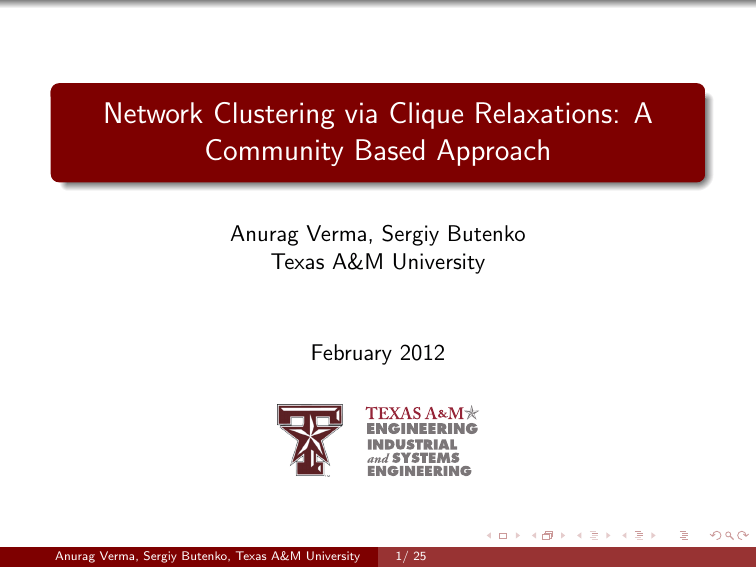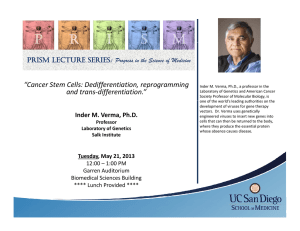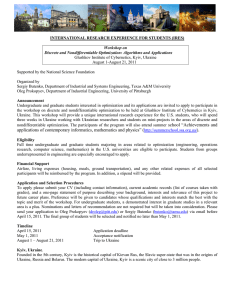Network Clustering via Clique Relaxations: A Community Based Approach Texas A&M University
advertisement

Network Clustering via Clique Relaxations: A Community Based Approach Anurag Verma, Sergiy Butenko Texas A&M University February 2012 Anurag Verma, Sergiy Butenko, Texas A&M University 1/ 25 Table of contents 1 Introduction 2 Clique Relaxations 3 Network Clustering using Clique Relaxations Anurag Verma, Sergiy Butenko, Texas A&M University 2/ 25 Clique WordNet dictionary An exclusive circle of people with a common purpose. Luce and Perry (1949) Social clique – a group of people that know (are friends of) all other people in the group. Figure: The “perfect cluster” Anurag Verma, Sergiy Butenko, Texas A&M University 3/ 25 However ... Perfect may mean impractical. Some examples: Furthermore, finding large cliques is often computationally expensive. Anurag Verma, Sergiy Butenko, Texas A&M University 4/ 25 Using clique relaxations Instead of cliques, using clique relaxations could provide better results: Restricting a violation of a clique defining property: s-plex: Each vertex is connected to all but s nodes in the induced subgraph. s-club: The diameter of the induced subgraph is at most s. γ-quasi-clique: The density of the subgraph is at least γ. Ensuring the presence of a clique defining property: k-Core: Each vertex has k neighbors in the induced subgraph. k-Community: Every edge has at least k neighboring nodes (A node is a neighbor of an edge if it is a neighbors with both its end points). A clique of size ω is a 1-plex, 1-club, 1-quasi-clique, (ω − 1)-core and (ω − 2)-community. Anurag Verma, Sergiy Butenko, Texas A&M University 5/ 25 Examples of clique relaxations Both sets of 5 nodes form a 2-plex, 2-club, 3-core, 1-community, 0.8-quasi-clique. Anurag Verma, Sergiy Butenko, Texas A&M University 6/ 25 Some background on k-community k-community was introduced to develop scale reduction techniques for the maximum clique problem. If we know a lower bound lω on the clique size, then we can be sure that the (lω − 2)-community contains the maximum clique in the graph. This is much tighter than finding the (lω − 1)-core as done by Abello et al (1999). Iteratively remove edges that have less than k neighboring nodes (O(mk∆)). Maximum cliques were obtained on all graphs in the SNAP database (graphs with up to 4 million nodes). Anurag Verma, Sergiy Butenko, Texas A&M University 7/ 25 Why k-community? All the clique relaxations defined earlier help us in identifying large clusters. For participating in this challenge, we chose k-communities for Tightness as a cluster when compared to k-cores. Computational ease when compared to the remaining relaxations (can be found in polynomial time). Anurag Verma, Sergiy Butenko, Texas A&M University 8/ 25 Participating in the challenge Found out about the challenge two weeks before the extended paper submission deadline! Since k-communities identify large cohesive clusters, why not use them for developing a clustering algorithm? Anurag Verma, Sergiy Butenko, Texas A&M University 9/ 25 k-Community clustering Consider the following algorithm: 1 2 3 4 Find the largest k 0 such that the k 0 -community of G is non-empty. Place all the k 0 -communities of G in distinct clusters. Remove from G all the nodes that have been placed in a cluster. Repeat steps 1-3 until k 0 = 0 or all nodes have been clustered. Computational complexity: O(m∆3 ). Anurag Verma, Sergiy Butenko, Texas A&M University 10/ 25 k-Community clustering Anurag Verma, Sergiy Butenko, Texas A&M University 11/ 25 k-Community clustering Anurag Verma, Sergiy Butenko, Texas A&M University 11/ 25 k-Community clustering Anurag Verma, Sergiy Butenko, Texas A&M University 11/ 25 k-Community clustering Anurag Verma, Sergiy Butenko, Texas A&M University 11/ 25 The football example Football Networks: node - NCAA football teams, edge - played a game in 2001.1 115 nodes, 613 edges. 1 Girvan & Newman, Proc Natl. Acad. Sci., 2002. Anurag Verma, Sergiy Butenko, Texas A&M University 12/ 25 The football example Actually: 11 Conferences, 5 independents. Clustering: 13 Clusters, 4 independents. Diagram generated by GraphViz. Anurag Verma, Sergiy Butenko, Texas A&M University 13/ 25 k-Community clustering Figure: Definition of a cluster matters! In both the cases, 2-clubs would cluster the graph. Anurag Verma, Sergiy Butenko, Texas A&M University 14/ 25 k-Community clustering 1 Measures to evaluate a clustering: Modularity, Performance, Minimum intra-cluster density, Average inter-cluster expansion. 2 The proposed clustering algorithm does not aim to optimize any of the quantitative measures of clustering quality. 3 The results of numerical experiments show that it performs quite well with respect to many such measures. 4 Algorithm coded in C++. Computations on a desktop computer. 5 Intel Core i7 860 @ 2.80GHz 8-core, 64 bit, 8GB RAM. Anurag Verma, Sergiy Butenko, Texas A&M University 15/ 25 Computational Results - Modularity Table: Name celegans metabolic email polblogs power PGPgiantcompo astro-ph memplus as-22july06 cond-mat-2005 kron g500-simple-logn16 preferentialAttachment G n pin pout smallworld luxembourg.osm rgg n 2 17 s0 caidaRouterLevel coAuthorsCiteseer citationCiteseer coPapersDBLP eu-2005 in-2004 belgium.osm 333SP Modularity of clusters found by using the k-community clustering. Single core desktop PC. n m Mod Cov M-Cov Perf Aixc Aixe Mid Time 453 1133 1490 4941 10680 16706 17758 22963 40421 65536 100000 100000 100000 114599 131072 192244 227320 268495 540486 862664 1382908 1441295 3712815 2025 5451 16715 6594 24316 121251 54196 48436 175691 2456071 499985 501198 499998 119666 728753 609066 814134 1156647 15245729 16138468 13591473 1549970 11108633 0.31 0.39 0.21 0.85 0.73 0.54 0.54 0.36 0.51 -0.02 0.00 0.18 0.57 0.01 0.61 0.60 0.69 0.43 0.67 0.44 0.63 0.02 0.00 0.57 0.44 0.40 0.87 0.74 0.54 0.64 0.76 0.51 0.34 0.92 0.45 0.57 1.00 0.61 0.62 0.69 0.45 0.67 0.45 0.63 0.99 1.00 0.82 0.95 0.89 0.99 1.00 1.00 0.97 0.59 1.00 0.67 0.02 0.72 1.00 0.01 1.00 0.99 1.00 0.98 1.00 0.99 1.00 0.02 0.00 0.82 0.95 0.88 0.99 1.00 1.00 0.97 0.59 1.00 0.67 0.02 0.72 1.00 0.01 1.00 0.99 1.00 0.98 1.00 0.99 1.00 0.02 0.00 0.50 0.60 0.09 0.17 0.21 0.40 0.25 0.45 0.45 0.00 0.91 0.80 0.50 0.28 0.45 0.40 0.32 0.50 0.44 0.67 0.40 0.32 0.49 3.34 5.65 2.22 0.49 0.99 2.88 1.42 2.20 2.41 0.39 26.71 8.83 4.93 0.84 4.72 2.03 1.88 4.25 9.69 21.58 12.89 0.99 2.89 0.04 0.02 0.03 0.01 0.01 0.04 0.00 0.00 0.01 0.00 0.00 0.00 0.13 0.00 0.20 0.00 0.01 0.00 0.18 0.00 0.00 0.00 0.01 0.03 0.08 0.50 0.13 0.72 9.12 0.89 1.31 11.76 708.82 31.84 44.13 10.25 7.94 19.16 116.65 170.59 287.20 14383.00 121419.00 33522.00 1212.34 9968.71 Anurag Verma, Sergiy Butenko, Texas A&M University 16/ 25 Comparison with Newman’s Fast Algorithm Table: Comparison Modularity found by Newman’s Fast Algorithm on some select graphs Graph Newman2 k-Core k-Community 0.44 0.40 0.48 0.73 0.33 0.20 0.31 0.67 0.28 0.31 0.39 0.73 Jazz Celegans Metabolic Email PGP 2 Duch & Arenas, Phy. Rev. E, 2005. Anurag Verma, Sergiy Butenko, Texas A&M University 17/ 25 Competing for modularity... 1 Should we stop k 0 from going all the way to zero to make sure only tight clusters are formed? 2 Should assign unclustered nodes to one of the clusters based on some criteria? 3 Should we join two clusters formed during the course of the algorithm? Should we split clusters? 4 Should we move individual nodes from one cluster to another if that improves modularity? Anurag Verma, Sergiy Butenko, Texas A&M University 18/ 25 Competing for modularity... 1 Should we stop k 0 from going all the way to zero to make sure only tight clusters are formed? YES!! 2 Should assign unclustered nodes to one of the clusters based on some criteria? YES! 3 Should we join two clusters formed during the course of the algorithm? Should we split clusters?umm.. 4 Should we move individual nodes from one cluster to another if that improves modularity?maybe.. (highest increase 0.04) Anurag Verma, Sergiy Butenko, Texas A&M University 18/ 25 The football example Actually: 11 Conferences, 5 independents. No Enhancement: 13 Conferences, 4 independents. Clustering: 12 Clusters, 8 independents. Diagram generated by GraphViz. Anurag Verma, Sergiy Butenko, Texas A&M University 19/ 25 The football example Actually: 11 Conferences, 5 independents. No Enhancement: 13 Conferences, 4 independents. Clustering: 12 Clusters, 0 independents. Diagram generated by GraphViz. Anurag Verma, Sergiy Butenko, Texas A&M University 20/ 25 Computational Results with the Enhancements Table: Modularity of clusters found by using the k-community clustering with the enhancements. Single core desktop PC. Name celegans metabolic email polblogs power PGPgiantcompo astro-ph memplus as-22july06 cond-mat-2005 kron g500-best-logn16 preferentialAttachment G n pin pout smallworld luxembourg.osm rgg n 2 17 s0 caidaRouterLevel coAuthorsCiteseer citationCiteseer coPapersDBLP eu-2005 in-2004 belgium.osm n m Mod Cov M-Cov Perf Aixc Aixe Mid Time 453 1133 1490 4941 10680 16706 17758 22963 40421 65536 100000 100000 100000 114599 131072 192244 227320 268495 540486 862664 1382908 1441295 2025 5451 16715 6594 24316 121251 54196 48436 175691 2456071 499985 501198 499998 119666 728753 609066 814134 1156647 15245729 16138468 13591473 1549970 0.33 0.51 0.43 0.86 0.85 0.59 0.54 0.55 0.59 0.01 0.23 0.21 0.75 0.73 0.78 0.77 0.80 0.63 0.68 0.59 0.83 0.98 0.70 0.57 0.93 0.87 0.89 0.61 0.77 0.66 0.60 0.52 0.56 0.21 0.75 0.99 0.78 0.81 0.80 0.65 0.68 0.59 0.84 0.98 0.69 0.95 0.67 0.99 0.96 1.00 0.76 0.89 1.00 0.66 0.67 1.00 1.00 0.73 1.00 0.96 1.00 0.99 1.00 0.99 1.00 1.00 0.69 0.95 0.68 0.99 0.96 1.00 0.76 0.89 1.00 0.66 0.67 1.00 1.00 0.73 1.00 0.96 1.00 0.99 1.00 0.99 1.00 1.00 0.40 0.46 0.01 0.15 0.10 0.59 0.23 0.34 0.71 0.00 0.44 0.79 0.28 0.04 0.24 0.96 0.18 0.35 0.35 0.54 0.36 0.05 2.98 4.11 0.02 0.43 0.48 2.10 1.53 1.26 1.96 0.07 4.41 7.97 2.83 0.11 2.79 2.15 1.58 3.11 11.78 21.72 9.51 0.13 0.03 0.07 0.04 0.01 0.00 0.00 0.00 0.00 0.02 0.00 0.00 0.02 0.02 0.00 0.08 0.00 0.00 0.00 0.09 0.00 0.00 0.00 0.11 0.36 0.45 0.83 1.61 39.10 9.02 12.56 48.19 869.34 216.45 317.19 109.09 193.98 245.13 386.70 674.91 790.05 12297.60 120100.00 49121.80 23532.90 Anurag Verma, Sergiy Butenko, Texas A&M University 21/ 25 Effect of the enhancements Anurag Verma, Sergiy Butenko, Texas A&M University 22/ 25 Comparison with Newman’s Fast Algorithm Table: Comparison of Modularity found by Newman’s Fast Algorithm on some select graphs Graph Jazz Celegans Metabolic Email PGP Newman k-Comm k-Comm++ 0.44 0.40 0.48 0.73 0.28 0.31 0.39 0.73 0.43 0.33 0.51 0.85 Anurag Verma, Sergiy Butenko, Texas A&M University 23/ 25 Conclusion Introduced a general purpose clustering algorithm (not modularity maximization) based on clique relaxations. User can customize the algorithm by defining what a cluster should look like. Algorithm does not aim to optimize any performance measure used in the challenge. Using k-community as a structure does well for a number of clustering quality measures. Enhancements to the basic algorithm can be designed according to requirements. Anurag Verma, Sergiy Butenko, Texas A&M University 24/ 25 Thank You! Anurag Verma, Sergiy Butenko, Texas A&M University 25/ 25


